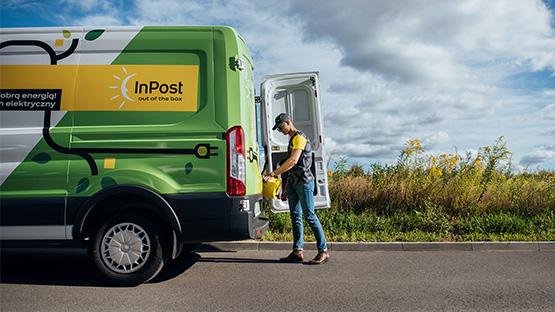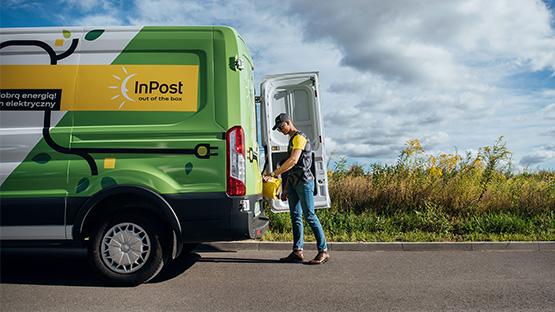
Manage your CO2 emissions with our carbon footprint reports


Every decision counts in your e-commerce
As an entrepreneur, you play the crucial role in the global fight against climate change. Your daily choices regarding supply chain management, types of packaging used, energy sources and product range have a direct impact on the environment. Therefore, it is of utmost importance that you are aware of this, and strive to actively manage the carbon footprint of your parcels - we make this possible!

Get your parcel carbon footprint report
We have created an innovative tool – our own carbon footprint calculator, which was developed in accordance with the international GHG Protocol standard. This solution gives you access to detailed data on CO2 emissions at every stage of the delivery process of your parcels. The tool that we have developed utilizes indicators from reputable databases, such as KOBIZE and DEFRA, ensuring its accuracy and reliability of information.
In order to meet the needs of our customers, we provide information on emissions in two ways: taking into account emissions from operational and financial activities related to the transport of parcels, or only monitoring emissions from the direct delivery of parcels. These two reporting methods were additionally divided into WTW and TTW.
Application form
Register using our form and start receiving recurring, quarterly
carbon footprint reports covering the transport of your parcels.*
Reliable data
Precise calculation methods are designed to provide you with detailed information on CO2 emissions at every stage – from dispatch to the final delivery to the customer. This comprehensive approach covers all parts of the transport chain, including emissions related to the first, middle and last mile, as well as energy consumption in logistics facilities and the transfer of data required to handle and track the parcel.
Deloitte Advisory sp. z o.o. sp. k. conducted an independent review of the compliance of the methodology and assumptions adopted by InPost with the GHG Protocol guidelines.
It is also worth mentioning that in 2023, all our parcel lockers were powered by green energy thanks to the purchase and redemption of Guarantees of Origin, which confirms that it came from renewable energy sources - wind and sun. We will do the same in 2024. Thanks to this, CO2 emissions from the operation of the Paczkomat® device are zero!
Our calculations are based on the following
logistic model:
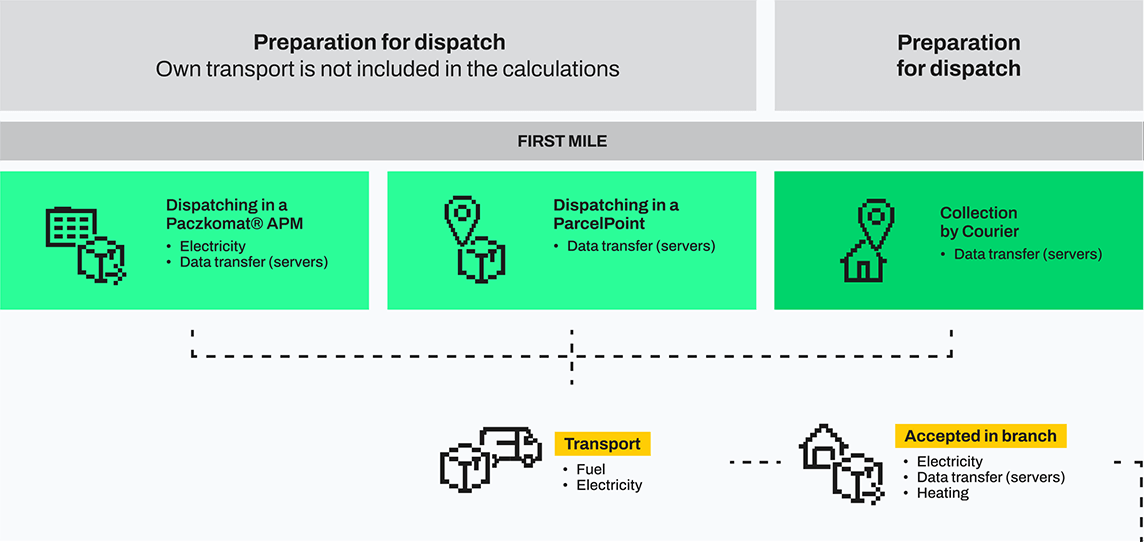

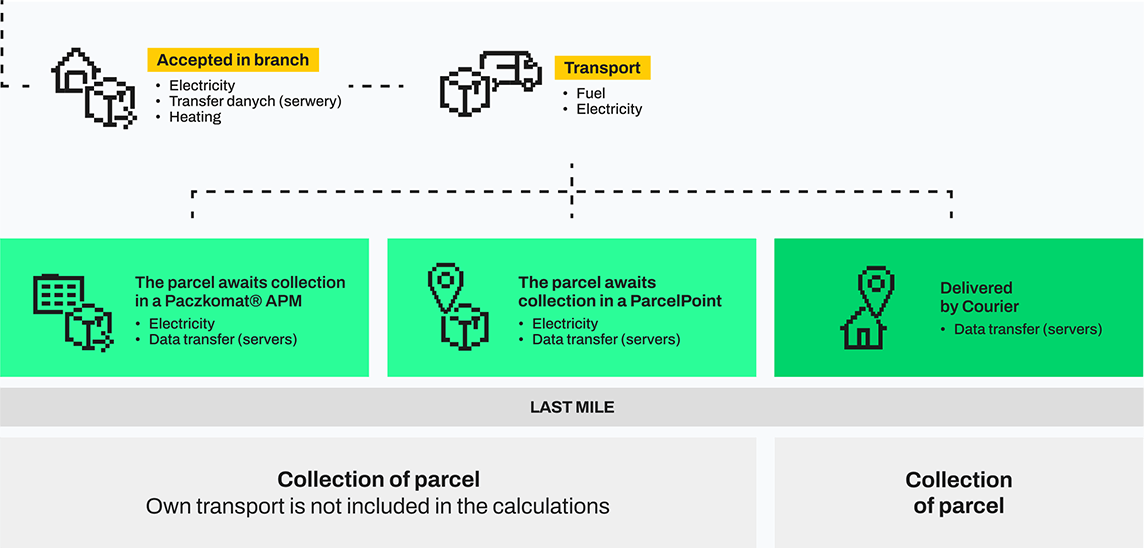


Your contribution to ecology
Companies that pursue sustainability goals are committed to monitoring and reducing emissions, including those related to the delivery process. The implementation of such practices in your company will not only allow you to manage the impact of parcel transport on the environment more efficiently, but also increase the trust of your customers.
In the era of growing environmental awareness, transparency in activities relating to carbon footprint constitutes a crucial factor that can influence the choice of your brand. Informing you about actions to reduce your carbon footprint can therefore become an important element in building a strong, positive reputation of your company.

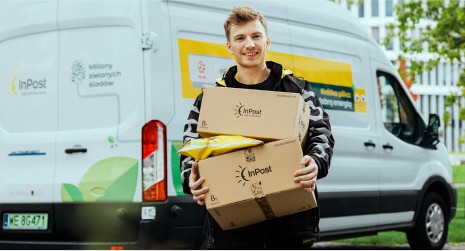
Building customer trust
transparency on environmental issues boosts brand image.
Competitive advantage
companies actively working for the environment are often preferred by conscious consumers.
Process optimization
analysis of your carbon footprint can reveal areas where it is possible to increase operational efficiency and reduce costs.
Compliance with the Regulations
in the face of increasing environmental regulations, i.e. the CSRD or CSDDD directives, knowledge and management of the carbon footprint will help you adapt to legal requirements.
We are shaping the future together
We invite you to join us in monitoring the carbon footprint of your parcels and to take a conscious steps towards sustainability. Together, we can create a future, where e-commerce is not only effective, but also transparent and friendly to our planet.
Together we can change the world for the better, step by step, parcel by parcel.
Q&A
Check out the frequently asked questions:
1. What is a carbon footprint?
The carbon footprint is a kind of “footprint” left by our activities that shows how much carbon dioxide (CO2) and other greenhouse gases are emitted into the atmosphere. These gases are the cause of global warming, i.e. an increase in the global temperature. Our activities, e.g. car use, food and energy production, make us emit greenhouse gases. By measuring our carbon footprint, we can understand how much our actions affect the climate and how to reduce these negative impacts through more environmentally friendly choices.
2. What data will I you in the report?
The parcel carbon footprint takes into account both emissions from the transport itself (from the moment of dispatch to the receipt of the parcel – i.e. emissions from the first, middle and last mile), as well as resulting from heating and electricity consumption in the facilities where the parcel is stored (Paczkomat parcel locker/ branches/ sorting plants) and related to the transfer of data necessary to handle and track the parcel. Dispatches and collections of parcels both by courier and in Paczkomat devices, Parcel points, Branches and Sorting plants (only shipments for dedicated commercial parcels) were also included. The calculation framework refers to the so-called ideal parcel transport process – from the moment of sending to the moment of receipt in accordance with the delivery method selected by the customer. The additional parcel path resulting, for example, from the storage/re-routing process is already indirectly taken into account in the calculations (the carbon footprint results are corrected upwards for emissions that may be the result of additional logistics processes on the last mile)
3. What is the "last mile" and why is it such an important stage of parcel delivery?
The "last mile" is a term used in logistics and transport, referring to the ultimate stage of parcel delivery from a warehouse or distribution centre to its final destination, i.e. the customer. The last mile is of great importance in the context of sustainable transport and reduction of greenhouse gas emissions. That is why at InPost we are constantly looking for greener and more efficient delivery solutions, such as deliveries by electric vehicles, the use of courier bicycles or the collection of parcels by a parcel locker, to reduce the environmental impact and reduce congestion in cities.
4. What exactly does CO2 mean?
CO2 is short for carbon dioxide. It is one of the most important greenhouse gases present in the Earth's atmosphere. CO2 plays crucial role in the greenhouse effect process. Greenhouse gases, such as carbon dioxide, trap solar heat at the Earth's surface, which contributes to climate warming. The increase in CO2 levels in the atmosphere, mainly due to human activities such as burning fossil fuels (coal, oil and natural gas), leads to global warming and climate change. CO2 is also necessary for life on Earth, as plants use it in the process of photosynthesis to produce energy and oxygen that we breathe. However, excessive CO2 emissions from industrial activities, transport and other sources can lead to dangerous climate changes such as sea level rise, extreme weather conditions and loss of biodiversity. Therefore, controlling CO2 emissions has become the priority in the field of environmental protection and combating climate change.
5. How do the CO2e emissions differ from the CO2 emissions?
CO2e emissions (carbon dioxide equivalent) differ from CO2 emissions in that they include other greenhouse gases that also contribute to the greenhouse effect and climate change. This means that different greenhouse gases are converted into equivalent amounts of CO2 to allow for a comparison of their impact on climate change. CO2e also includes gases such as methane (CH4) and nitrous oxide (N2O), which are much more potent greenhouse gases than the CO2, but are present in smaller quantities.
6. How often do you update the benchmarks in the calculator?
Our objective is to present results based on the latest benchmarks. According to the calculator methodology, these benchmarks will be updated annually. In a situation where there is no new benchmark in the databases at the time of updating, we will automatically leave the one from the previous year.
7. Are your calculations compliant with international standards?
Yes, they are. Our calculations are based on two GHG Protocol standards. The first is the GHG Protocol Corporate Accounting and Reporting Standard, which contains requirements and guidance for companies and other organizations preparing an inventory of greenhouse gas emissions at the corporate level. The second is The Corporate Value Chain (Scope 3) Accounting and Reporting Standard, which allows companies to assess the impact of the entire value chain on emissions and determine where reduction actions should focus.
8. Was the calculator methodology subject to an external audit?
Yes, our calculator methodology was assessed by an external auditor, Deloitte Advisory sp. A.a.
9. What information will I receive in my report?
In order to adapt to the needs of our customers and enable a convenient way to use the data, the carbon footprint of parcel delivery is reported both with and without taking into account the emissions from operational and financial activities, divided into WTW (Well-to-Wheel) and TTW (Tank-to-Wheel).
10. What does the WTW method mean?
WTW (Well-to-Wheel) is a term related to the analysis of energy efficiency and emissions related to motor vehicles. It refers to an analysis that takes into account the entire energy supply chain, from the primary source (e.g. raw material extraction, fuel production) to the final use in the vehicle itself. The WTW analysis includes greenhouse gas emissions and energy consumption at all stages of production, transport and consumption of fuel and vehicle power. This approach takes into account the full environmental impact of the fuel or energy source.
11. What does the TTW method mean?
The term TTW (Tank-to-Wheel) refers to the analysis of the vehicle's energy chain, which begins at the point where energy is supplied (for example, during refuelling) and covers all stages until it is used while driving. TTW is used to assess both the fuel consumption of the vehicle and the exhaust emissions generated by the vehicle during use.
12. When will I receive the report?
The report will be sent on a quarterly basis and an additional annual report will be generated after the end of the calendar year.
13. What is the CSRD about?
The Corporate Sustainability Reporting Directive (CSRD) constitutes the crucial element of European sustainability policy. It aims to increase transparency of the impact that businesses have on the environment and society. The CSRD extends and supports the existing provisions on non-financial reporting previously introduced under the NFRD (Non-Financial Reporting Directive).
Pursuant to the CSRD, many more companies will be required to submit annual reports on their impact on the environment, communities, workers, human rights and the fight against corruption. These reports must be more detailed and include, among other things, information on greenhouse gas emissions, resource consumption, sustainability progress, and the impact of the company's operations on employees and local communities.
These new regulations aim not only to increase the transparency of companies' activities, but also at providing investors, customers and other stakeholders with a more comprehensive image of companies' activities, enabling them to better assess their sustainable practices and strategies. In the result, investors and customers will be able to make more informed choices, which will contribute to promoting a more sustainable and responsible approach in the business world.
More information on CSRD can be found in the official text of the directive available at the webpage
14. What does the CSDDD concern?
The Corporate Sustainability Due Diligence Directive (CSDDD) is an important step towards increasing corporate responsibility in the field of sustainable development. It is an initiative of the European Union, which aims to improve responsibility of businesses for the impact of their activities on human rights and the environment.
Under the CSDDD, companies are required to carry out regular, comprehensive risk assessments that must cover their entire value chain – from raw materials to the final product. Any potential or actual negative impacts of the company's activities on human rights and the environment are assessed.
The pivotal element of the Directive is the obligation for companies to take appropriate measures to prevent, minimise and mitigate the negative impact of their activities and those of their subsidiaries and business partners.
In addition, the CSDDD requires companies to accurately record and report their due diligence activities, which includes both strategies and policies as well as specific actions and their results. This transparency requirement is designed not only to increase corporate responsibility, but also to enable stakeholders, including investors and consumers, to assess a company's sustainability performance.
More information on CSDDD can be found in the official text of the directive available at the webpage
15. What does the GHG Protocol stand for?
The Greenhouse Gas Protocol was created in 1998 by the World Resources Institute (WRI) and the World Business Council for Sustainable Development (WBCSD). The GHG Protocol establishes comprehensive global standardized framework structures to assess and manage greenhouse gas emissions (CGHG) from private and state activities, value chains, and mitigation actions.
